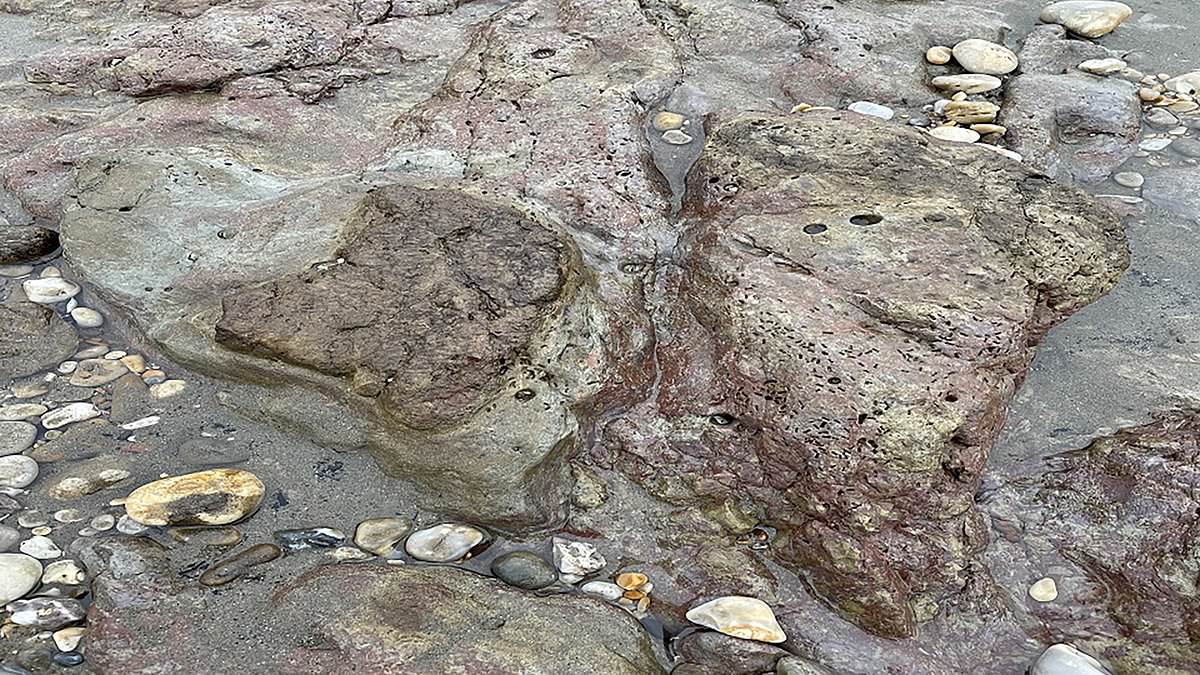Engineers on the Isle of Wight had a surprise this week after stumbling across well-preserved dinosaur footprints.
The prints were discovered by accident in Yaverland during excavation work to boost sea defences.
The three-toed tracks are believed to belong to a 125million-year-old creature called a mantellisaurus, which was an impressive 23ft long (seven metres), according to experts from the Dinosaur Isle museum in Sandown.
‘A fully grown mantellisaurus would have been almost twice the length of an average car, marching a slow thunder with huge strides that have clearly left their mark on time,’ said Dr Martin Munt, curator of the museum.
Engineers on the Isle of Wight stumbled across well-preserved dinosaur footprints
The three-toed tracks are believed to belong to a 125million-year-old creature called a mantellisaurus (artist’s impression)
Engineers at the Environment Agency made the discovery near the beachside cafe in Yaverland.
Fossils are often found on the Isle of Wight.
It is believed the mantellisaurus weighed 1,653lb (750kg) and walked around on its hind legs.
‘We cannot be totally sure about a print’s identity, but the three-toed feet makes it likely a mantellisaurus was here, not just in other parts of the South Coast where they were more common – or that’s what we thought until now,’ Dr Munt said.
The engineers who uncovered the footprints were on site to work up plans to improve flood defences for more than 600 properties in Shanklin and Yaverland.
Nick Gray, the Environment Agency’s flood and coastal-risk manager for the Solent and South Downs area, said: ‘Dinosaurs existing right where our team is working brings old and new together – the modern challenges of combating climate change with a period of time we can only imagine.
‘We’ve all read the stories and seen the films, but this gives us just a hint of what life was like.’
The engineers who uncovered the footprints were on site to improve flood defences for more than 600 properties in Shanklin and Yaverland
Experts hope the finding will cement the Isle of Wight as Britain’s dinosaur capital.
Stuart Noon, heritage leader for sea defences contractor JBA consulting, added: ‘This represents a hugely important and significant discovery for the project, as finding the new footprints makes it clear that the land on which the dinosaurs walked is likely to stretch the whole length of Yaverland beach.
‘The latest capture cements the Isle of Wight as Britain’s dinosaur capital.’
The discovery comes shortly after the remains of what may be the largest predatory dinosaur ever found in Europe were unearthed on the Isle of Wight.
Paleontologists say the huge crocodile-faced dinosaur – which at 32.8ft (ten metres) long almost as big as a London Bus – lived 125million years ago and would have weighed several tons.
The ‘giant killer’ was a member of the spinosaurids, the first dinosaurs known to swim, so may have been able to hunt in the water as well as on land.
It would have lived at the beginning of a period of rising sea levels and would have stalked lagoons and sandflats in search of food.
HOW THE DINOSAURS BECAME EXTINCT AROUND 66MILLION YEARS AGO
Dinosaurs ruled the Earth around 66million years ago, but suddenly disappeared in what is known as the Cretaceous-Tertiary extinction.
It was believed for many years that the changing climate destroyed the food chain of the huge reptiles.
However, in the 1980s paleontologists discovered a layer of iridium – an element that is rare on Earth but found in vast quantities in space.
When this was dated, it coincided precisely with when the dinosaurs disappeared from the fossil record.
A decade later, scientists uncovered the massive Chicxulub Crater at the tip of Mexico’s Yucatán Peninsula, which dates to the period in question.
Scientific consensus now says that these two factors are linked and they were both probably caused by an enormous asteroid crashing to Earth.
With the projected size and impact velocity, the collision would have caused an enormous shock wave and is likely to have triggered seismic activity.
The fallout would have created plumes of ash thought to have covered the whole planet, making it impossible for dinosaurs to survive.
Other animals and plant species had a shorter time-span between generations which allowed them to survive.
There are several other theories as to what caused the demise of the dinos.
One early theory was that small mammals ate dinosaur eggs and another proposes that toxic angiosperms (flowering plants) killed them off.
